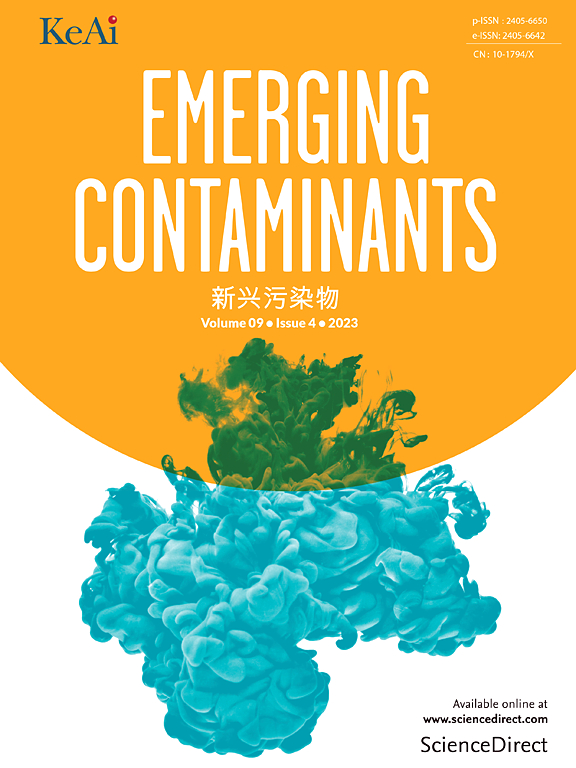Organophosphate ester contamination in long-term plasticulture soils: Co-occurrence of tri/di-OPEs, influence factors, source Attribution, and environmental risks
IF 6.9
2区 环境科学与生态学
Q1 ENVIRONMENTAL SCIENCES
引用次数: 0
Abstract
This study focused on the pollution characteristics, influencing factors, and source apportionment of organophosphate triesters (tri-OPEs) and diesters (di-OPEs) in the plastic greenhouses soils with cultivation periods ranging from 6 to 32 years. The concentrations of Σ13tri-OPEs and Σ5di-OPEs in soil samples ranged from 39.60 to 730.52 ng/g dw and 2.25–6.94 ng/g dw, respectively. Tris (chloroethyl) phosphate was the predominant tri-OPE, while dibutyl phosphate was the most abundant di-OPE. The levels of OPEs pollution increased with the age of mulch film, highlighting the impact of the duration of mulch film usage on OPE accumulation. The type of fertilizer significantly impacted OPE levels. Soil samples treated with compound fertilizers showed the highest concentration of tri-OPEs, reaching up to 205.32 ng/g dry weight. In contrast, the highest concentration of di-OPEs was found in soil samples treated with water-soluble fertilizers, with a peak of 3.89 ng/g dry weight. Total organic carbon, pH, total nitrogen, and total phosphorus had minimal effect on OPEs levels. According to the Positive Matrix Factorization Model, the primary sources of OPEs included the use of pesticides, food packaging materials, and small-scale machinery (48.39 %), water and reclaimed water irrigation (17.68 %), the utilization of agricultural films (17.39 %), and atmospheric deposition and degradation processes (16.54 %). Compared to the moderate risks associated with compounds such as tri-2-ethyl phosphate, 2-ethylhexyl diphenyl phosphate, and tris(1-chloro-2-propyl) phosphate, tris(chloroethyl) phosphate exhibited a higher risk level in soil samples. This study offers insights into the potential risks linked to OPE contamination in agricultural soils.
长期塑料栽培土壤中的有机磷酸酯污染:三/二有机磷酸酯的共存、影响因素、来源归属和环境风险
研究了6 ~ 32年栽培期塑料大棚土壤中有机磷三酯(tri-OPEs)和二酯(dii - opes)的污染特征、影响因素及来源解析。土壤样品中Σ13tri-OPEs和Σ5di-OPEs的浓度分别为39.60 ~ 730.52 ng/g dw和2.25 ~ 6.94 ng/g dw。三(氯乙基)磷酸是主要的三- ope,而磷酸二丁酯是最丰富的二- ope。OPEs污染水平随地膜使用年限的增加而增加,突出地膜使用时间对OPEs积累的影响。肥料类型显著影响OPE水平。复合肥处理的土壤样品中三opes含量最高,达到205.32 ng/g干重。水溶性肥料处理的土壤样品中,二opes的浓度最高,峰值为3.89 ng/g干重。总有机碳、pH、总氮和总磷对OPEs水平的影响最小。根据正矩阵分解模型,OPEs的主要来源包括农药、食品包装材料和小型机械的使用(48.39%)、水和再生水灌溉(17.68%)、农膜利用(17.39%)和大气沉积和降解过程(16.54%)。与3 -2-乙基磷酸、2-乙基己基磷酸和三(1-氯-2-丙基)磷酸等化合物的中度风险相比,三(氯乙基)磷酸在土壤样品中表现出更高的风险水平。这项研究提供了与农业土壤中有机磷污染有关的潜在风险的见解。
本文章由计算机程序翻译,如有差异,请以英文原文为准。
求助全文
约1分钟内获得全文
求助全文
来源期刊

Emerging Contaminants
Medicine-Public Health, Environmental and Occupational Health
CiteScore
10.00
自引率
6.70%
发文量
35
审稿时长
44 days
期刊介绍:
Emerging Contaminants is an outlet for world-leading research addressing problems associated with environmental contamination caused by emerging contaminants and their solutions. Emerging contaminants are defined as chemicals that are not currently (or have been only recently) regulated and about which there exist concerns regarding their impact on human or ecological health. Examples of emerging contaminants include disinfection by-products, pharmaceutical and personal care products, persistent organic chemicals, and mercury etc. as well as their degradation products. We encourage papers addressing science that facilitates greater understanding of the nature, extent, and impacts of the presence of emerging contaminants in the environment; technology that exploits original principles to reduce and control their environmental presence; as well as the development, implementation and efficacy of national and international policies to protect human health and the environment from emerging contaminants.
 求助内容:
求助内容: 应助结果提醒方式:
应助结果提醒方式:


